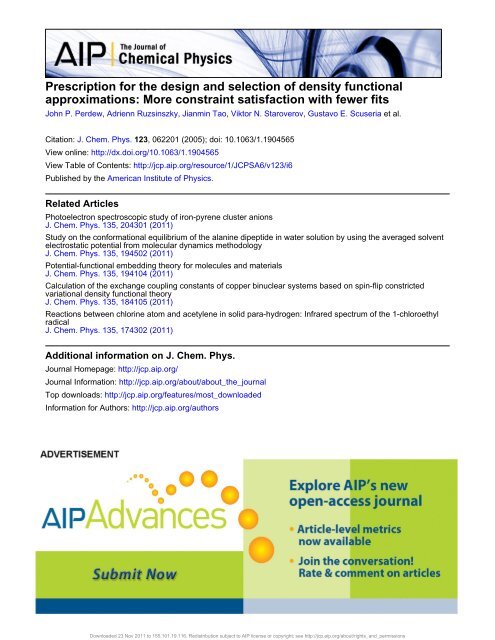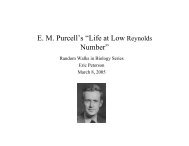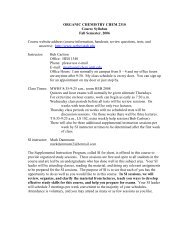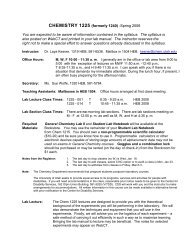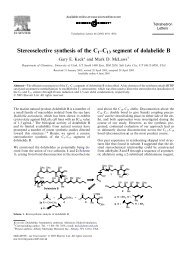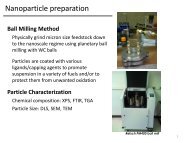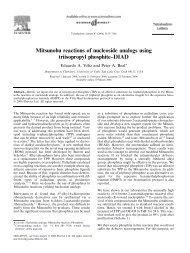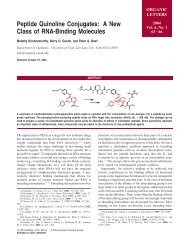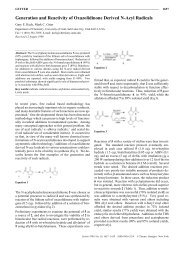Jacob's Ladder of DFT - Department of Chemistry
Jacob's Ladder of DFT - Department of Chemistry
Jacob's Ladder of DFT - Department of Chemistry
You also want an ePaper? Increase the reach of your titles
YUMPU automatically turns print PDFs into web optimized ePapers that Google loves.
Prescription for the design and selection <strong>of</strong> density functional<br />
approximations: More constraint satisfaction with fewer fits<br />
John P. Perdew, Adrienn Ruzsinszky, Jianmin Tao, Viktor N. Staroverov, Gustavo E. Scuseria et al.<br />
Citation: J. Chem. Phys. 123, 062201 (2005); doi: 10.1063/1.1904565<br />
View online: http://dx.doi.org/10.1063/1.1904565<br />
View Table <strong>of</strong> Contents: http://jcp.aip.org/resource/1/JCPSA6/v123/i6<br />
Published by the American Institute <strong>of</strong> Physics.<br />
Related Articles<br />
Photoelectron spectroscopic study <strong>of</strong> iron-pyrene cluster anions<br />
J. Chem. Phys. 135, 204301 (2011)<br />
Study on the conformational equilibrium <strong>of</strong> the alanine dipeptide in water solution by using the averaged solvent<br />
electrostatic potential from molecular dynamics methodology<br />
J. Chem. Phys. 135, 194502 (2011)<br />
Potential-functional embedding theory for molecules and materials<br />
J. Chem. Phys. 135, 194104 (2011)<br />
Calculation <strong>of</strong> the exchange coupling constants <strong>of</strong> copper binuclear systems based on spin-flip constricted<br />
variational density functional theory<br />
J. Chem. Phys. 135, 184105 (2011)<br />
Reactions between chlorine atom and acetylene in solid para-hydrogen: Infrared spectrum <strong>of</strong> the 1-chloroethyl<br />
radical<br />
J. Chem. Phys. 135, 174302 (2011)<br />
Additional information on J. Chem. Phys.<br />
Journal Homepage: http://jcp.aip.org/<br />
Journal Information: http://jcp.aip.org/about/about_the_journal<br />
Top downloads: http://jcp.aip.org/features/most_downloaded<br />
Information for Authors: http://jcp.aip.org/authors<br />
Downloaded 23 Nov 2011 to 155.101.19.116. Redistribution subject to AIP license or copyright; see http://jcp.aip.org/about/rights_and_permissions
Prescription for the design and selection <strong>of</strong> density functional<br />
approximations: More constraint satisfaction with fewer fits<br />
John P. Perdew, Adrienn Ruzsinszky, and Jianmin Tao<br />
<strong>Department</strong> <strong>of</strong> Physics and Quantum Theory Group, Tulane University, New Orleans, Louisiana 70118<br />
Viktor N. Staroverov and Gustavo E. Scuseria<br />
<strong>Department</strong> <strong>of</strong> <strong>Chemistry</strong>, Rice University, Houston, Texas 77005<br />
Gábor I. Csonka<br />
<strong>Department</strong> <strong>of</strong> Inorganic <strong>Chemistry</strong>, Budapest University <strong>of</strong> Technology and Economics,<br />
H-1521 Budapest, Hungary<br />
Received 18 August 2004; accepted 17 March 2005; published online 17 August 2005<br />
We present the case for the nonempirical construction <strong>of</strong> density functional approximations for the<br />
exchange-correlation energy by the traditional method <strong>of</strong> “constraint satisfaction” without fitting to<br />
data sets, and present evidence that this approach has been successful on the first three rungs <strong>of</strong><br />
“Jacob’s ladder” <strong>of</strong> density functional approximations local spin-density approximation LSD,<br />
generalized gradient approximation GGA, and meta-GGA. We expect that this approach will also<br />
prove successful on the fourth and fifth rungs hyper-GGA or hybrid and generalized random-phase<br />
approximation. In particular, we argue for the theoretical and practical importance <strong>of</strong> recovering the<br />
correct uniform density limit, which many semiempirical functionals fail to do. Among the<br />
beyond-LSD functionals now available to users, we recommend the nonempirical Perdew–Burke–<br />
Ernzerh<strong>of</strong> PBE GGA and the nonempirical Tao–Perdew–Staroverov–Scuseria TPSS meta-GGA,<br />
and their one-parameter hybrids with exact exchange. TPSS improvement over PBE is dramatic for<br />
atomization energies <strong>of</strong> molecules and surface energies <strong>of</strong> solids, and small or moderate for other<br />
properties. TPSS is now or soon will be available in standard codes such as GAUSSIAN, TURBOMOLE,<br />
NWCHEM, ADF, WIEN, VASP, etc. We also discuss old and new ideas to eliminate the self-interaction<br />
error that plagues the functionals on the first three rungs <strong>of</strong> the ladder, bring up other related issues,<br />
and close with a list <strong>of</strong> “do’s and don’t’s” for s<strong>of</strong>tware developers and users. © 2005 American<br />
Institute <strong>of</strong> Physics. DOI: 10.1063/1.1904565<br />
I. INTRODUCTION<br />
Kohn–Sham spin-density functional theory 1–4 is now the<br />
most widely used method for electronic structure calculations<br />
in condensed matter physics and quantum chemistry,<br />
providing useful predictions for atoms, molecules including<br />
biomolecules, nanostructures, solids, and solid surfaces. A<br />
recent study 5 <strong>of</strong> the papers published and cited in the Physical<br />
Review family <strong>of</strong> journals 1893–2003 shows that the<br />
three most-cited ones are all density functional theory papers<br />
Refs. 1, 6, and 7 in this work. These data do not include the<br />
myriad citations <strong>of</strong> this theory to and from chemistry journals,<br />
but citations from chemistry are included in another<br />
datum: 8 The most-cited physics paper published since the<br />
beginning <strong>of</strong> 1994 is our Ref. 9, which presents the nonempirical<br />
construction <strong>of</strong> a gradient-corrected density functional.<br />
Moreover, <strong>of</strong> the five papers most cited by chemists in<br />
2003, four are density functional theory papers. 10<br />
Kohn–Sham theory looks and, more importantly, scales<br />
with system size 11 like a mean-field theory with a selfconsistent<br />
effective one-electron Schrödinger equation for<br />
the Kohn–Sham orbitals, but includes, in principle, all correlation<br />
effects on the ground-state electron density and total<br />
energy. Useful extensions <strong>of</strong> the theory to thermal equilibrium<br />
at finite temperature and to excited or time-dependent<br />
THE JOURNAL OF CHEMICAL PHYSICS 123, 062201 2005<br />
states have also been made. 2,3 In principle, only the density<br />
functionals for exchange and correlation remain to be approximated.<br />
The “due diligence” requirement <strong>of</strong> good science<br />
demands some understanding <strong>of</strong> what these approximations<br />
are and how they are constructed, not only from the<br />
developers but also from the users and even the opponents <strong>of</strong><br />
density functional theory.<br />
We are writing this paper for all <strong>of</strong> these potential readers<br />
to express our personal preferences and metaphysical<br />
principles for the construction and selection <strong>of</strong> density functional<br />
approximations. We will argue that the traditional nonempirical<br />
approach <strong>of</strong> construction by “constraint<br />
satisfaction” 1,9,12–14 remains the most convincing, most universal,<br />
and most enduring one, making full use <strong>of</strong> the many<br />
known exact constraints on the density functional for the<br />
exchange-correlation energy. In this approach, the density<br />
functional approximations are assigned to various rungs <strong>of</strong><br />
“Jacob’s ladder,” 15 according to the number and kind <strong>of</strong> their<br />
local ingredients. The lowest rung is the local spin-density<br />
approximation <strong>of</strong> Kohn and Sham, 1 the second rung is the<br />
generalized gradient approximation, and so on. Higher rungs<br />
are increasingly more complex. The best nonempirical functional<br />
for a given rung is constructed to satisfy as many exact<br />
theoretical constraints as possible while providing satisfactory<br />
numerical predictions for real systems. Once a rung has<br />
0021-9606/2005/1236/062201/9/$22.50 123, 062201-1<br />
© 2005 American Institute <strong>of</strong> Physics<br />
Downloaded 23 Nov 2011 to 155.101.19.116. Redistribution subject to AIP license or copyright; see http://jcp.aip.org/about/rights_and_permissions
062201-2 Perdew et al. J. Chem. Phys. 123, 062201 2005<br />
been selected, there remains little choice about which constraints<br />
to satisfy but greater freedom in how to satisfy<br />
them. Accuracy is expected to increase up the ladder as<br />
additional local ingredients enable the satisfaction <strong>of</strong> additional<br />
constraints.<br />
The strengths <strong>of</strong> density functional theory are practicality,<br />
universality for all electronic ground states, and a<br />
sound theoretical foundation. As complexity and accuracy<br />
increase up Jacob’s ladder, conceptual simplicity and computational<br />
ease necessarily decrease. The required computational<br />
cost does not increase much from the first to the third<br />
rung, but it increases rapidly on higher rungs, especially the<br />
fifth. Thus the holy grail <strong>of</strong> density functional theory is not<br />
just the fifth or highest rung, but the whole nonempirical<br />
ladder.<br />
At least on the first four rungs, the only known alternative<br />
to “constraint satisfaction” is “semiempirical<br />
fitting,” 16–20 in which the functionals are fitted to selected<br />
data from experiment or from ab initio calculations. Of<br />
course, the additional ingredients that arise at higher rungs <strong>of</strong><br />
Jacob’s ladder can also accommodate more fit parameters.<br />
Functionals with as many as 21 fit parameters, violating<br />
some <strong>of</strong> the most basic exact constraints, are especially<br />
popular in chemistry. Our traditional view that the functionals<br />
should be constructed with few empirical parameters and<br />
preferably none is now a minority opinion for which we will<br />
present a rationale. We will point to recent developments<br />
which show the continuing power <strong>of</strong> the nonempirical constraint<br />
satisfaction approach and discuss possible future developments<br />
along the same general direction.<br />
We disagree strongly with the suggestion that traditional<br />
density functional theory is at an “impasse.” Progress is slow<br />
but accelerating. It took 26 years to develop a successful<br />
nonempirical second rung, and 12 more years to do the same<br />
for the third rung. Each completed nonempirical rung is a<br />
platform from which to construct the next. Progress will continue<br />
until and unless a real impasse is reached.<br />
The developers <strong>of</strong> density functionals are somewhat like<br />
the blind men who tried to describe the elephant in the wellknown<br />
fable. Each <strong>of</strong> us has hold <strong>of</strong> a different part <strong>of</strong> the<br />
beast, and so describes it differently. Only by pooling our<br />
information and synthesizing the parts will we develop a true<br />
picture <strong>of</strong> the elephant.<br />
II. IS DENSITY FUNCTIONAL THEORY AB INITIO?<br />
Knowing quantum mechanics and Coulomb’s law for the<br />
electron-electron interaction, we know almost everything we<br />
need, in principle, for the description <strong>of</strong> atoms, molecules,<br />
and solids. Numerical studies based upon the correlated<br />
many-electron wave function can be ab initio, although computationally<br />
intractable for large molecules or unit cells. The<br />
underlying principles <strong>of</strong> quantum mechanics and Coulomb’s<br />
law are accepted as universally valid and basic. This acceptance<br />
is itself grounded in experiment, as all good science is.<br />
Starting from these principles, we can derive 1,21 the<br />
Kohn–Sham ground-state density functional theory and<br />
prove that the ground-state exchange-correlation energy is a<br />
functional <strong>of</strong> the total electron density nr or <strong>of</strong> the separate<br />
up and down spin densities n ↑r and n ↓r. We can also<br />
prove many exact properties Sec. VI <strong>of</strong> this functional to<br />
constrain our approximation to it. But this functional is<br />
known neither exactly nor as a systematic series <strong>of</strong> approximations<br />
converging in every case to the exact answer the<br />
highest expectation <strong>of</strong> a fully ab initio theory.<br />
So is density functional theory ab initio or semiempirical?<br />
We suggest that it can fall in between as a nonempirical<br />
theory when the functionals are constructed by constraint<br />
satisfaction without empirical fitting. It is this middle way<br />
that is advocated here.<br />
Language that is now widely used tends to be contradictory<br />
and confusing. Some papers distinguish between ab initio<br />
wave function-based and “density functional” calculations,<br />
suggesting in a subtle and perhaps unintentional way<br />
that density functional theory is semiempirical. Other papers<br />
refer to density functional calculations as “first principles” or<br />
ab initio, but that is a long stretch when the underlying functional<br />
has, for example, eight fit parameters, as does the<br />
popular B3LYP, 22 even though these parameters are fixed<br />
once for all by a particular fitting to a given data set. B3LYP<br />
has one empirical parameter in its Becke exchange, 17 four in<br />
its LYP Ref. 18 correlation, and three more in the hybridization<br />
with exact exchange.<br />
A fully ab initio but practical density functional approximation<br />
would be good for users but would terminate the<br />
interest <strong>of</strong> many developers, as it would leave too little room<br />
for creative play. A semiempirical density functional approximation,<br />
however, leaves too much room, encouraging an<br />
“anything that works” attitude. Many popular functionals including<br />
B3LYP are not exact even in the one limit uniform<br />
density in which they could be. As Wordsworth said,<br />
“Strange fits <strong>of</strong> passion have I known.” 23 A nonempirical<br />
density functional is most interesting from the developer’s<br />
viewpoint, since its construction requires disciplined imagination<br />
and insight as well as trial and error.<br />
Semiempirical fitting leaves unexplained all the data that<br />
was fitted. It can make very accurate predictions for systems<br />
and properties that are sufficiently similar to those fitted, but<br />
can fail badly when the new systems and properties are sufficiently<br />
different. In particular, higher-level functionals that<br />
are fitted to molecular data can be far less accurate 24 for the<br />
bulk and surface properties <strong>of</strong> simple metals than even the<br />
lowest-level functional, the local-spin density approximation.<br />
Thus users who want reliable high accuracy for a broad<br />
range <strong>of</strong> systems need a practical, high-level, nonempirical<br />
functional.<br />
A given rung <strong>of</strong> Jacob’s ladder Sec. IV is too restrictive<br />
in form to be exact and must have intrinsic accuracy limits.<br />
Thus fitting a given data set too closely can result in “overfitting.”<br />
There are two senses in which a semiempirical functional<br />
<strong>of</strong> a given form can be overfitted. The first, which can<br />
be avoided by a careful mathematical analysis, involves the<br />
introduction <strong>of</strong> artificial zigs and zags that reduce the fitting<br />
error, or the introduction <strong>of</strong> more parameters than are really<br />
justified. For example, the three mixing parameters in the<br />
B3PW91 Ref. 25 or B3LYP Ref. 22 hybrids can be<br />
reduced 26 to one 27–30 without a significant overall error increase,<br />
and the optimum value <strong>of</strong> this parameter to predict<br />
Downloaded 23 Nov 2011 to 155.101.19.116. Redistribution subject to AIP license or copyright; see http://jcp.aip.org/about/rights_and_permissions
062201-3 Design and selection <strong>of</strong> density functional approximations J. Chem. Phys. 123, 062201 2005<br />
molecular atomization energies can even be rationalized. 28<br />
The second sense is the inevitable bias that arises in the<br />
selection <strong>of</strong> a given fitting set and weights for this set.<br />
In answer to a semi-humorous question from a semiempirical<br />
colleague, we admit that there are many nonfundamental<br />
parameters in the analytic expression for the uniformgas<br />
correlation energy, and further such parameters on the<br />
third rung <strong>of</strong> the nonempirical ladder. We regard the parameters<br />
needed to satisfy exact constraints for functional forms<br />
suited to satisfy such constraints as nonempirical. There are<br />
many similar parameters in nonempirical pseudopotentials.<br />
One <strong>of</strong> the authors <strong>of</strong> this paper is old enough to recall<br />
the history <strong>of</strong> the electron-ion pseudopotential in condensed<br />
matter physics. The 1960s and 1970s saw the appearance <strong>of</strong><br />
many realistic semiempirical pseudopotentials. When accurate<br />
nonempirical pseudopotentials became available, 31 the<br />
semiempirical ones quickly and permanently disappeared<br />
from the literature. We expect the history <strong>of</strong> density functional<br />
theory to follow a parallel course. Despite this expectation,<br />
we observe that much has been and will continue to<br />
be learned from semiempirical density functionals and from<br />
those who develop them.<br />
III. WHY THE UNIFORM DENSITY LIMIT IS<br />
SACROSANCT<br />
The paradigm density for condensed matter physics is<br />
also one <strong>of</strong> the simplest possible ones, the uniform density in<br />
which n ↑r and n ↓r are independent <strong>of</strong> position r. The<br />
periodic valence-electron density in a bulk solid especially a<br />
simple metal has some resemblance to this uniform density.<br />
The earliest and simplest spin-density functional for the<br />
exchange-correlation energy was the local spin-density<br />
LSD approximation 1<br />
LSD<br />
Exc n↑,n↓ = d3 unif<br />
rnxc n↑,n↓, 1<br />
unif<br />
where xc n↑,n ↓ is the exchange-correlation energy per<br />
particle <strong>of</strong> an electron gas with uniform spin densities n↑ and<br />
n↓, known accurately from quantum Monte Carlo and other<br />
many-electron methods. 32 For accurate parametrizations <strong>of</strong><br />
unif n↑,n ↓, see Refs. 33 and especially 34. By construction,<br />
xc<br />
Eq. 1 is exact in the one limit in which it can be, namely,<br />
the limit <strong>of</strong> uniform spin densities. This limit is preserved in<br />
all nonempirical density functionals, but lost 32 in many semiempirical<br />
ones which as a result can fail seriously for the<br />
bulk and surface properties <strong>of</strong> simple metals. 24<br />
In our view, if an approximation fails to be essentially<br />
exact for the limited class <strong>of</strong> systems where it can be, it is a<br />
self-contradiction and should not underpin any major area <strong>of</strong><br />
science. The most widely used functional in quantum chemistry,<br />
B3LYP, underestimates the magnitude <strong>of</strong> the correlation<br />
energy <strong>of</strong> the uniform gas by about 30% Ref. 32 as<br />
inherited from the 50% underestimation <strong>of</strong> LYP. In fact, the<br />
original three-parameter hybrid proposed by Becke, 25<br />
B3PW91, was a semiempirical functional designed to be exact<br />
for the uniform electron gas. B3LYP was later favored<br />
because <strong>of</strong> its slightly better performance for a data set <strong>of</strong><br />
small molecules, although it is now clear that B3PW91 performs<br />
better than B3LYP for large organic molecules. 35<br />
The correlation energy <strong>of</strong> the uniform electron gas is<br />
divergent to second or higher finite order in the electronelectron<br />
interaction, requiring an infinite resummation as in<br />
the random phase approximation or coupled cluster method.<br />
Thus density functionals built upon finite-order perturbation<br />
theory will not be discussed further here.<br />
The local spin-density approximation is so accurate for<br />
solids that it is still widely used in condensed matter physics.<br />
It is less useful for atoms and molecules, which bear less<br />
resemblance to a uniform electron gas and are better described<br />
by the functionals on higher rungs <strong>of</strong> Jacob’s ladder.<br />
But even a practical chemist should respect the uniform density<br />
limit, since he or she may someday have to deal with a<br />
molecule chemisorbed to the surface <strong>of</strong> a simple metal.<br />
In fact, the relatively poor LSD atomization energies<br />
have led to an undervaluation <strong>of</strong> LSD in chemistry. LSD<br />
gives remarkably accurate bond lengths, 35 and the errors <strong>of</strong><br />
its atomization energies can be dramatically reduced by introducing<br />
one empirical parameter to represent the energy <strong>of</strong><br />
each free atom. 36 For chemistry without free atoms, LSD is<br />
not such a bad starting point.<br />
IV. JACOB’S LADDER OF DENSITY FUNCTIONAL<br />
APPROXIMATIONS<br />
Although many generalizations <strong>of</strong> the LSD <strong>of</strong> Eq. 1<br />
were proposed, the first practical one was the generalized<br />
gradient approximation GGA, 9,13,17,18,37–41<br />
GGA<br />
Exc n↑,n↓ = d3 GGA<br />
rnxc n↑,n↓,n ↑,n↓, 2<br />
which introduces the density gradients n↑r and n↓r as<br />
GGA<br />
additional local ingredients or arguments <strong>of</strong> xc . While<br />
LSD is the first, GGA is the second rung <strong>of</strong> Jacob’s ladder.<br />
The original motivation for Eq. 2 was the second-order<br />
gradient expansion GEA,<br />
GEA<br />
Exc n↑,n↓ = d3rnxc unif n↑,n↓ + C<br />
<br />
xc n↑,n↓ ,<br />
n · n 2/3 2/3 , 3<br />
n n<br />
an expression valid for slowly varying densities. The coefficients<br />
C<br />
<br />
xc were derived in the hope that Eq. 3 would<br />
improve upon LSD for real solids and even for molecules,<br />
but this hope was disappointed. Langreth and Perdew 12 identified<br />
the root <strong>of</strong> the problem, which was also the key to the<br />
development <strong>of</strong> new functionals by the method <strong>of</strong> constraint<br />
satisfaction as defined in the Introduction.<br />
The exact exchange-correlation energy can be expressed<br />
by the adiabatic connection or coupling constant<br />
integration, 42,43<br />
Downloaded 23 Nov 2011 to 155.101.19.116. Redistribution subject to AIP license or copyright; see http://jcp.aip.org/about/rights_and_permissions
062201-4 Perdew et al. J. Chem. Phys. 123, 062201 2005<br />
Excn↑,n↓ = 1<br />
d 2 3rnr d3 1<br />
r d<br />
0<br />
nxc n↑,n↓;r,r .<br />
r − r<br />
4<br />
We consider a series <strong>of</strong> systems having the same groundstate<br />
density nr, different electron-electron repulsions<br />
/r−r where the coupling constant falls in the range 0<br />
1, and corresponding external potentials vr. The<br />
real system has =1 and the Kohn–Sham noninteracting sys-<br />
<br />
tem has =0.InEq.4, nxcn↑,n ↓;r,r is the density at<br />
r <strong>of</strong> the exchange-correlation hole surrounding an electron<br />
at r,<br />
<br />
nxc = nx + nc , 5<br />
where the exchange hole density nx is independent <strong>of</strong> . Note<br />
<br />
that nxc can be found from the correlated wave function for a<br />
given . The exact exchange-correlation hole has the following<br />
key properties: 14,42,43<br />
d 3 r n xr,r =−1, 6<br />
d 3 r n c r,r =0, 7<br />
n xr,r 0. 8<br />
The LSD hole, being the hole <strong>of</strong> a possible physical system<br />
the uniform electron gas, satisfies Eqs. 6–8, which constrain<br />
Eq. 4 to reasonable values. The LSD “on-top” hole<br />
,LSD 44<br />
density nxc r,r is also nearly exact. However, the GEA<br />
hole, being only the expansion <strong>of</strong> a hole to second order in<br />
, has a spurious large r−r behavior that violates Eqs.<br />
6–8. Simple cut<strong>of</strong>fs that restore some or all <strong>of</strong> these constraints<br />
led to the first GGAs, which markedly improved the<br />
calculated total and atomization energies <strong>of</strong> molecules.<br />
Our recommended nonempirical GGA is that <strong>of</strong> Perdew,<br />
Burke, and Ernzerh<strong>of</strong> PBE. 9 It has two different derivations,<br />
one which it shares with its PW91 twin, 40 the first<br />
completely nonempirical GGA based upon satisfying the<br />
constraints 6–8 on the system-averaged hole, 41 and the<br />
other based upon satisfying constraints on the exchangecorrelation<br />
energy itself. 9 Revisions 45–47 <strong>of</strong> PBE are constructed<br />
to satisfy at most only the second set <strong>of</strong> constraints,<br />
not the first, and so are less convincing. These revisions typically<br />
work better than PBE for the atomization energies <strong>of</strong><br />
molecules their target property, but worse than PBE for<br />
molecular bond lengths 48,49 and for lattice constants and surface<br />
energies <strong>of</strong> solids. 24 Note that the only constants<br />
present in PBE, besides those in its LSD part, are fundamental<br />
constants.<br />
Adding the next natural set <strong>of</strong> local ingredients produces<br />
the meta-GGA Refs. 14, 19, and 50–54 or third rung <strong>of</strong><br />
Jacob’s ladder:<br />
MGGA<br />
Exc n↑,n↓ = d3rn MGGA<br />
xc n↑,n↓,n ↑,n↓, 2n↑,2n ↓,↑, ↓.<br />
9<br />
The Laplacians 2 n r seem like the more natural next step,<br />
since they appear in the fourth-order gradient expansion, but<br />
the Kohn–Sham orbital kinetic energy densities,<br />
r = 1<br />
2 occ.<br />
ir i<br />
2 , 10<br />
which appear in the Taylor expansion <strong>of</strong> the exchange hole<br />
density about r−r=0, are also implicit functionals <strong>of</strong> the<br />
density and permit the satisfaction <strong>of</strong> more constraints Sec.<br />
VI than the Laplacians do. They carry the same information<br />
in the limit <strong>of</strong> a slowly varying density, since 55<br />
GEA unif 1 n = +<br />
72<br />
2<br />
+<br />
n 1<br />
6 2n, 11<br />
where unif = 3<br />
10 62 2/3 n 5/3 .<br />
The only nonempirical meta-GGA for exchange and correlation<br />
is that <strong>of</strong> Tao, Perdew, Staroverov, and Scuseria<br />
TPSS, 54 which utilizes only ↑ and ↓ without 2 n ↑ and<br />
2 n ↓. It is constructed by satisfying only constraints on the<br />
exchange-correlation energy, but we can probably “reverseengineer”<br />
TPSS exchange and correlation holes 56 satisfying<br />
the hole constraints <strong>of</strong> Eqs. 6–8. Extensive numerical<br />
tests 35,57–64 <strong>of</strong> TPSS suggest that the nonempirical constraint<br />
satisfaction approach continues to work on the meta-GGA<br />
level, producing a functional that is fully competitive with<br />
semiempirical ones. Compared to PBE, TPSS greatly improves<br />
atomization energies for molecules and surface energies<br />
for solids.<br />
LSD is a local and GGA is a semilocal functional <strong>of</strong> the<br />
density. Meta-GGA is a semilocal functional <strong>of</strong> the density<br />
and the occupied orbitals, which are readily available in any<br />
Kohn–Sham-like calculation. Semilocal functionals are expected<br />
to work best when the exact exchange-correlation<br />
hole is well localized around its electron, as it is in slowly<br />
varying and in compact e.g., spherical electron densities.<br />
Although we stress LSD and our own nonempirical generalizations<br />
<strong>of</strong> it, we note that some other nonempirical functionals<br />
have been proposed. The first GGA, as proposed in<br />
Ref. 13, was largely nonempirical. A meta-GGA for exchange,<br />
based not upon the uniform gas but upon the hydrogen<br />
atom, was proposed in Ref. 50. And a meta-GGA for<br />
correlation, based in part upon the picture <strong>of</strong> a uniform gas<br />
with an energy gap, was proposed in Ref. 65.<br />
Higher rungs <strong>of</strong> Jacob’s ladder necessarily introduce a<br />
more computationally challenging nonlocal functional <strong>of</strong> the<br />
orbitals. The fourth rung adds as a local ingredient the exact<br />
exchange energy density,<br />
Downloaded 23 Nov 2011 to 155.101.19.116. Redistribution subject to AIP license or copyright; see http://jcp.aip.org/about/rights_and_permissions
062201-5 Design and selection <strong>of</strong> density functional approximations J. Chem. Phys. 123, 062201 2005<br />
FIG. 1. Jacob’s ladder <strong>of</strong> density functional approximations to the<br />
exchange-correlation energy.<br />
xr = 1<br />
d 2 3r nx r,r<br />
r − r<br />
=−<br />
1<br />
2n r d 3 r<br />
occ. * irir<br />
i<br />
2<br />
r − r<br />
12<br />
or any quantity such as the exact exchange energy that can<br />
be found from it. The hyper-GGA Refs. 15 and 66 is then<br />
HGGA<br />
Exc n↑,n↓ = d3rn HGGA<br />
xc n↑,n↓,n ↑,n↓, ↑,↓, x↑,x↓. 13<br />
Semiempirical hyper-GGAs include the widely used global<br />
hybrid functionals such as B3LYP, B3PW91, or PBE0 Refs.<br />
29 and 30 that mix a fixed fraction <strong>of</strong> exact exchange with<br />
GGA exchange, and the local hybrids. 67 Although the global<br />
hybrid functionals can be remarkably accurate for molecules<br />
and strongly inhomogeneous solids, they are theoretically<br />
less than ideal because they do not satisfy any exact constraints<br />
that GGAs do not satisfy. We are working 66 on<br />
hyper-GGAs that at least retain all the exact features <strong>of</strong> the<br />
TPSS meta-GGA; the simplest <strong>of</strong> these is the TPSS global<br />
hybrid <strong>of</strong> Ref. 35.<br />
The fifth and final rung <strong>of</strong> Jacob’s ladder utilizes all <strong>of</strong><br />
the Kohn–Sham orbitals, unoccupied as well as occupied. At<br />
this level the adiabatic connection <strong>of</strong> Eq. 4 leads to<br />
generalizations 68–71 <strong>of</strong> the random phase approximation<br />
RPA that obviate the need for electron gas data in fact,<br />
generating this data, and also account for the long-range van<br />
der Waals attraction between nonoverlapped electron densities.<br />
These generalizations are still based upon constraint satisfaction,<br />
but at a higher level. A Kohn–Sham version <strong>of</strong> the<br />
coupled cluster method 72,73 is fully ab initio. Fifth rung functionals<br />
require huge basis sets and are not yet practical for<br />
general use.<br />
Figure 1 shows Jacob’s ladder rising half dream and<br />
half reality from the Hartree world <strong>of</strong> unrealistically weak<br />
or missing bonding in five steps to the heaven <strong>of</strong> chemical<br />
accuracy. Note that it is not only the higher rungs that have<br />
value. The lower rungs may be less accurate, but they are<br />
also simpler to understand and they require less programming<br />
and computation time. The users are the “angels,” who<br />
ascend or descend the ladder at will.<br />
In our own nonempirical constructions, we try to follow<br />
a conservative “do not reinvent the wheel” approach. Thus,<br />
our functionals resemble Chinese boxes or Russian dolls:<br />
LSD is inside the PBE GGA, PBE GGA is inside the TPSS<br />
meta-GGA, and TPSS meta-GGA will probably be inside our<br />
hyper-GGA.<br />
From the nonempirical viewpoint, LSD and GGA are<br />
controlled extrapolations from the slowly varying limit,<br />
while meta-GGA and hyper-GGA are controlled interpolations<br />
between the limits <strong>of</strong> slowly varying and compact oneor<br />
two-electron densities the paradigm densities for condensed<br />
matter physics and quantum chemistry, respectively.<br />
The remaining constraints “control” the extrapolation or interpolation.<br />
We believe that the first three rungs are essentially<br />
completed by the LSD, PBE, and TPSS functionals<br />
respectively. We encourage users to report and compare their<br />
results for all three <strong>of</strong> these functionals. Nonempirical functionals<br />
on the fourth and fifth rungs remain to be developed<br />
or adequately tested. Although the hybrid functionals on the<br />
fourth rung are semiempirical, we can also recommend the<br />
hybrids PBE0, 29,30 PBEh, 74 and TPSSh, 35 which satisfy<br />
many exact constraints and have at most one fit parameter.<br />
V. IS EXACT EXCHANGE NEEDED?<br />
The use <strong>of</strong> a fraction <strong>of</strong> exact exchange was introduced 25<br />
into density functional approximations to improve the calculated<br />
atomization energies <strong>of</strong> molecules, but at a significant<br />
computational cost. It was later shown 19 that flexible functional<br />
forms involving the kinetic energy density VSXC<br />
Ref. 19 were capable <strong>of</strong> yielding similar and even better<br />
thermochemistry without exact exchange. However, this was<br />
achieved at the cost <strong>of</strong> empirical parametrization. Now that<br />
accurate atomization energies are predicted by a nonempirical<br />
density functional without exact exchange TPSS, dowe<br />
still need exact exchange in chemistry?<br />
It seems that we do need exact exchange, or perhaps<br />
self-interaction correction Sec. VII, to describe situations in<br />
which the exact exchange-correlation hole has a long-range<br />
component that cannot be captured by semilocal approximations<br />
such as LSD, GGA, or meta-GGA. The simplest example<br />
is stretched H 2 + a highly noncompact one-electron<br />
density, but less extreme and more practical examples are<br />
moderately stretched molecules 58 and the transition state <strong>of</strong> a<br />
chemical reaction. The forward and reverse energy barriers<br />
tend to be seriously underestimated in LSD. These errors are<br />
typically reduced by about a factor <strong>of</strong> 2 in the PBE GGA or<br />
the TPSS meta-GGA, but the remaining error is still far too<br />
large for chemical kinetics. 64 The progression from LSD to<br />
PBE GGA to TPSS meta-GGA seems to show a consistent<br />
and continuing reduction <strong>of</strong> error only for reactions that do<br />
not involve a free H atom or H 2 molecule. The hybrid functionals<br />
that admix exact exchange, such as PBE0, achieve a<br />
significant further reduction <strong>of</strong> the error, but are still far from<br />
Downloaded 23 Nov 2011 to 155.101.19.116. Redistribution subject to AIP license or copyright; see http://jcp.aip.org/about/rights_and_permissions
062201-6 Perdew et al. J. Chem. Phys. 123, 062201 2005<br />
satisfactory. It appears that self-interaction correction can<br />
significantly improve energy barriers. 75 Perhaps a nonempirical<br />
hyper-GGA or an improved self-interaction correction<br />
will solve this problem, and will also improve the description<br />
<strong>of</strong> molecules containing transition-metal atoms where again<br />
TPSS makes only a small improvement 62 over PBE.<br />
Because inclusion <strong>of</strong> exact exchange implies moving up<br />
Jacob’s ladder, we expect hybrid and hyper-GGA functionals<br />
to provide a better description for solids as well. Direct<br />
evaluation <strong>of</strong> exact exchange for solids with metallic character<br />
remains prohibitively expensive, but the recently developed<br />
screened Coulomb potential method 74 for hybrid functionals<br />
overcomes this obstacle with only a slight loss <strong>of</strong><br />
precision.<br />
VI. SHORT SUMMARY OF KNOWN EXACT<br />
CONSTRAINTS ON E xc†n _,n `‡<br />
Here we will summarize some <strong>of</strong> the major known exact<br />
constraints on E xcn ↑,n ↓ and discuss whether or not they are<br />
satisfied by approximate functionals. Size-consistency extensivity<br />
is <strong>of</strong> course a basic constraint, but one that is always<br />
satisfied by semilocal functionals. Using as a local<br />
ingredient an integrated property like N=nrd 3 r or E x as in<br />
Ref. 76 can, however, violate size consistency.<br />
For the exchange energy, the spin-scaling relation 77<br />
Exn↑,n ↓ = 1<br />
2 Ex2n↑ + 1<br />
2 Ex2n↓ 14<br />
where ExnExn/2,n/2 and the uniform-density scaling<br />
relation 78<br />
E xn = E xn 15<br />
where nr= 3nr are satisfied by all the density functionals<br />
we know, whether nonempirical or semiempirical, as<br />
is the upper bound Exn↑,n ↓0.<br />
The Lieb–Oxford lower bound 79,80 expressed in terms<br />
<strong>of</strong> a local density approximation<br />
LSD<br />
Exn↑,n ↓ Excn↑,n↓ 2.273Ex n/2,n/2 16<br />
for all possible spin densities is satisfied by LSD and by the<br />
PBE GGA and TPSS meta-GGA. Most semiempirical functionals<br />
can violate this bound for possible but unrealistic<br />
densities. The bound is nonetheless important, and its satisfaction<br />
for all densities has implications for real densities.<br />
The correlation energy scales in the high-density limit to<br />
a constant, as shown by Levy: 81<br />
lim Ecn = const. 17<br />
→<br />
This condition is violated by LSD and by many semiempirical<br />
functionals, but satisfied by PBE GGA and TPSS meta-<br />
GGA. In the low-density limit under uniform scaling <br />
→0, correlation scales like exchange; within LSD, PBE<br />
GGA, and TPSS meta-GGA, the spin-density functionals<br />
Excn↑,n ↓ properly become density functionals Excn in this<br />
limit.<br />
For a uniform electron gas, 32,34 LSD, PBE GGA, and<br />
TPSS meta-GGA are all exact by construction, while many<br />
semiempirical functionals are not. The nonempirical func-<br />
tionals also have gradient expansions like Eq. 3 in the limit<br />
<strong>of</strong> slowly varying densities. In LSD, the gradient coefficients<br />
are all zero. PBE GGA and TPSS meta-GGA have correct<br />
second-order gradient coefficients for correlation. 12 The<br />
TPSS meta-GGA has correct gradient coefficients for exchange<br />
through fourth order in . 82,83 LSD, PBE GGA, and<br />
TPSS meta-GGA all have a reasonable linear response 61 for<br />
the uniform electron gas, although this is achieved in PBE<br />
GGA by using a second-order gradient coefficient for exchange<br />
that is too big by a factor <strong>of</strong> 1.778.<br />
For any one-electron density n 1r, we know that 7<br />
Exn1,0 =−Un1− 1<br />
d 2 3r d3r n1rn1r ,<br />
r − r<br />
18<br />
E cn 1,0 =0. 19<br />
In other words, the exchange energy <strong>of</strong> a fully spin-polarized<br />
one-electron system is a self-interaction correction to the<br />
Hartree-energy, and the correlation energy for such a system<br />
vanishes. Because the right-hand side <strong>of</strong> Eq. 18 is a fully<br />
nonlocal functional <strong>of</strong> the density, this constraint cannot be<br />
satisfied on the first three rungs <strong>of</strong> Jacob’s ladder, although it<br />
can be satisfied on the fourth rung by hyper-GGAs that use<br />
full exact exchange. Equation 19 cannot be satisfied on the<br />
first two rungs, but is satisfied by the TPSS meta-GGA on the<br />
third rung.<br />
The exact exchange potential, vxcr=E xc/n r, at<br />
the nuclear cusp <strong>of</strong> the electron density is finite. 84 This condition,<br />
satisfied by LSD, is necessarily lost in GGA, but is<br />
restored in the TPSS meta-GGA. The region around the<br />
nucleus is one in which the density is dominated by a single<br />
orbital shape and the reduced density gradient s<br />
=n/2321/3n4/3 is small; these conditions can also hold<br />
simultaneously near the centers <strong>of</strong> chemical bonds.<br />
As a consequence <strong>of</strong> Eqs. 15 and 17, the high-density<br />
→ limit <strong>of</strong> Excn↑,n ↓ is the exact exchange energy<br />
Exn↑,n ↓. 85 This condition can be satisfied on the fourth<br />
rung <strong>of</strong> Jacob’s ladder by hyper-GGAs that use full exact<br />
exchange. And so for that matter will any constraint on the<br />
exchange energy.<br />
There are also known constraints for nonuniform density<br />
scaling, 86<br />
whether two-dimensional n xy x,y,z<br />
= 2 nx,y,z or one-dimensional n x x,y,z=nx,y,z,<br />
which in the limit → can produce a crossover from a<br />
three- to a one- or two-dimensional electron density,<br />
respectively. 87<br />
Except in the one-electron and high-density limits, the<br />
most long-ranged parts <strong>of</strong> the exact exchange and correlation<br />
holes tend to cancel, 88 making E xcn ↑,n ↓ less strongly nonlocal<br />
than E xn ↑,n ↓. Thus it is unacceptable to combine exact<br />
exchange with meta-GGA correlation. Exact exchange<br />
can only be combined with a fully nonlocal correlation, constructed<br />
on the fourth or fifth rungs <strong>of</strong> the ladder.<br />
Downloaded 23 Nov 2011 to 155.101.19.116. Redistribution subject to AIP license or copyright; see http://jcp.aip.org/about/rights_and_permissions
062201-7 Design and selection <strong>of</strong> density functional approximations J. Chem. Phys. 123, 062201 2005<br />
VII. SELF-INTERACTION CORRECTION OF SEMI-<br />
LOCAL FUNCTIONALS, AND HOW TO IMPROVE IT<br />
The semilocal density functionals on the first three rungs<br />
<strong>of</strong> Jacob’s ladder violate Eq. 18 and those on the first two<br />
rungs also violate Eq. 19. Simple functionals that work<br />
well for many-electron systems cannot be exact for oneelectron<br />
systems. This problem was evident long ago within<br />
LSD, and led Perdew and Zunger 7 to propose a selfinteraction<br />
correction SIC to LSD or any other density<br />
functional approximation DFA:<br />
occ.<br />
SIC-DFA DFA<br />
Exc n↑,n↓ = Exc n↑,n↓ − <br />
i<br />
DFA<br />
Uñi + Exc ñi,0,<br />
20<br />
where ñ ir= ˜ ir 2 is the density <strong>of</strong> an occupied orbital<br />
in general, not a Kohn–Sham orbital but some more localized<br />
orbital constructed to minimize the self-interaction corrected<br />
energy. The SIC <strong>of</strong> Eq. 20 properly vanishes when<br />
the original density functional approximation is exact. This<br />
feature seems to be absent from a recently proposed alternative<br />
self-interaction correction to the one-electron<br />
potential. 89,90 However, even this feature does not make the<br />
self-interaction correction to a given DFA unique, except in<br />
the case <strong>of</strong> one-electron densities.<br />
The Perdew–Zunger SIC has a long history <strong>of</strong> striking<br />
successes and failures. 91–93 It appears that elimination <strong>of</strong> selfinteraction<br />
error is <strong>of</strong>ten important, but that Eq. 20 is not<br />
necessarily the best way to achieve this. In chemical applications,<br />
for example, the GGA seems to need only about<br />
40% Ref. 94 <strong>of</strong> the self-interaction correction presented in<br />
Eq. 20 although a simple scaling by 0.4 produces a functional<br />
that is no longer exact for one-electron densities. The<br />
results <strong>of</strong> SIC calculations <strong>of</strong> reaction barriers show us that a<br />
scaling factor <strong>of</strong> 0.5–0.7 is needed, depending on the reaction<br />
type and functional. 75,95 A systematic thermochemical<br />
study 96 shows that the Perdew–Zunger SIC indeed overcorrects<br />
beyond-LSD functionals.<br />
There are also formal problems with Eq. 20. Ifwefind<br />
localized orbitals for a uniform density, our SIC functional<br />
will no longer be exact in the uniform or slowly varying<br />
density limit. But if we find delocalized orbitals for a uniform<br />
density, then Eq. 20 will produce a “false surface<br />
energy” 91 for any finite jellium system.<br />
An alternative self-interaction correction 97 that avoids<br />
these formal difficulties while scaling down the selfinteraction<br />
correction for many-electron densities is found by<br />
introducing an effective orbital density at r for an electron<br />
<strong>of</strong> spin at r, i.e.,<br />
n rr− n x r,r, 21<br />
where n x r,r is the exact exchange hole density, and noting<br />
that 0 W /1, where is defined by Eq. 10 and<br />
W =n 2 /8n is the von Weizsäcker kinetic energy<br />
density:<br />
SIC-DFA DFA<br />
Exc n↑,n↓ = Exc n↑,n↓ − d 3 r<br />
W<br />
k<br />
n rUn r<br />
DFA<br />
+ Exc nr,0, 22<br />
where<br />
Unr = 1<br />
d 2 3r d3r nrrnrr 23<br />
r − r<br />
DFA<br />
and Exc nr,0 involves integration over r. For any one-<br />
W<br />
electron density <strong>of</strong> spin , /=1 and nrr=n r<br />
=nr. To preserve the correct slowly varying limit requires<br />
k3 when the DFA is the TPSS meta-GGA. Within TPSS,<br />
the correlation contribution to Eq. 22 vanishes. We must<br />
have k2 for the PBE GGA and k1 for LSD.<br />
Because nrr <strong>of</strong> Eq. 21, nr, and r are invariant<br />
under a unitary transformation <strong>of</strong> the occupied orbitals,<br />
no localizing transformation is needed in the implementation<br />
<strong>of</strong> the SIC-DFA <strong>of</strong> Eq. 22. Moreover, the effective oneelectron<br />
Hamiltonian with a nonmultiplicative potential for<br />
Eq. 22 is self-adjoint and its canonical orbitals are orthonormal.<br />
Although Eq. 22 may not be easy to implement, it<br />
has these interesting and promising formal properties in<br />
common with the meta- and hyper-GGAs.<br />
Why think about a self-interaction correction to the<br />
meta-GGA when the hyper-GGA will be exact for any oneelectron<br />
density? One answer is that the Perdew–Zunger SIC<br />
<strong>of</strong> Eq. 20 provides a nearly correct description <strong>of</strong> fractional<br />
particle number in a many-electron open system, 98 and this<br />
good description is not guaranteed in the hyper-GGA, which<br />
could thereby fail as do LSD, GGA, and meta-GGA to<br />
describe charge transfer correctly. A second answer is that<br />
DFA<br />
the SIC forms 20 and 22 do not require that x represent<br />
the same choice <strong>of</strong> energy density as the exact x. VIII. OTHER ISSUES<br />
A good density functional for the exchange-correlation<br />
energy should produce a realistic integrated energy and a<br />
realistic electron density. There is no reason to expect it to<br />
produce any given energy density, since the energy density is<br />
neither physical nor unique, although it can be useful for<br />
other purposes. 99–101 Energy density may be an issue for local<br />
hybrids 67 and hyper-GGAs. 15,66<br />
There is also no reason to expect the Kohn–Sham determinant<br />
to display all the symmetries <strong>of</strong> the true wave function.<br />
Symmetry breaking in the spin densities is more<br />
disturbing, 102<br />
but <strong>of</strong>ten has a simple physical<br />
interpretation. 103 Nor does a good density functional need to<br />
produce the spin resolution <strong>of</strong> the correlation energy into<br />
↑↑, ↓↓, and ↑↓ contributions. In fact, a widely used spin<br />
resolution is incorrect 104 in the uniform-density limit.<br />
An interesting recent development is the appearance <strong>of</strong><br />
tractable nonlocal density functionals that include the longrange<br />
van der Waals interaction. 105 It remains to be seen if<br />
those functionals can be merged with the various functionals<br />
on the first four rungs <strong>of</strong> Jacob’s ladder. There is also con-<br />
Downloaded 23 Nov 2011 to 155.101.19.116. Redistribution subject to AIP license or copyright; see http://jcp.aip.org/about/rights_and_permissions
062201-8 Perdew et al. J. Chem. Phys. 123, 062201 2005<br />
tinuing interest e.g., Ref. 106 in the weighted density approximation,<br />
a nonempirical and fully nonlocal functional<br />
that does not fit on Jacob’s ladder.<br />
We also note in passing that the orbitals that minimize<br />
the meta-GGA energy belong to a self-adjoint but nonmultiplicative<br />
effective one-electron Hamiltonian. However, it<br />
seems to make little energetic difference if one uses instead a<br />
multiplicative optimized effective potential 107–113 or even the<br />
PBE GGA potential. At the same time, proper inclusion <strong>of</strong><br />
exact exchange into the Kohn–Sham scheme via a multiplicative<br />
potential greatly improves the accuracy <strong>of</strong> singleparticle<br />
spectra 114 and is expected to be important for timedependent<br />
and excited-state applications. 115<br />
There have been many other interesting developments in<br />
density functional theory that are peripherally related to our<br />
topic. For example, it is possible both numerically 116 and<br />
analytically 117 to construct the exact Kohn–Sham potential<br />
from the correlated wave function. 118 Efforts have also been<br />
made to combine correlated wave functions with density<br />
functionals. 119,120<br />
IX. CONCLUSIONS<br />
We have argued that density functional approximations<br />
should be constructed nonempirically via the satisfaction <strong>of</strong><br />
known exact constraints valid for all densities or for a large<br />
class <strong>of</strong> them, and that the uniform density limit in particular<br />
is a logically required constraint. We realize that this nonempirical<br />
construction is a slow and uncertain process. It is<br />
hard to get everything right, and impossible to do so on the<br />
lower rungs <strong>of</strong> the ladder: for certain systems and properties,<br />
users may want to employ semiempirical or fitted functionals.<br />
In such cases, we recommend functionals that are correct<br />
for the uniform electron gas and contain few fitted parameters,<br />
such as PBE0 or TPSSh. Even then, we believe that<br />
results should also be reported for the nonempirical functionals<br />
like LSD in an accurate parametrization 33,34 , PBE GGA,<br />
and TPSS meta-GGA, as a measure <strong>of</strong> how much we really<br />
understand and what remains to be understood.<br />
Is there any secure place for empiricism in Kohn–Sham<br />
density functional theory? One such place may be the fourth<br />
rung <strong>of</strong> the ladder, where empiricism can tell us how much<br />
exact exchange to mix with semilocal functionals. The local<br />
or semilocal functionals on the first three rungs <strong>of</strong> the ladder<br />
work as well as they do for molecules because there is a<br />
strong cancellation between the full nonlocalities <strong>of</strong> exchange<br />
and correlation except in special cases: one-electron<br />
densities, high-density limit, etc.. Becke’s argument 25 tells<br />
us that a residue <strong>of</strong> exchange-like full nonlocality survives<br />
the cancellation, but not how much. A rationale 28 can be<br />
made for mixing 25% exact exchange with 75% GGA exchange,<br />
but this argument is itself based upon an empirical<br />
observation. On the fourth rung, we believe that at least the<br />
exact constraints satisfied on lower rungs should be preserved.<br />
Even here, we hope that empiricism can be completely<br />
avoided by modeling the adiabatic connection, somewhat<br />
as in Ref. 76. Note, however, that limited empiricism<br />
can provide a useful tack-on long-range van der Waals<br />
correction 121,122 to functionals on the lower rungs <strong>of</strong> the ladder,<br />
and perhaps a better general self-interaction correction<br />
as discussed in Sec. VII.<br />
We close with some general “do’s and don’t’s.” S<strong>of</strong>tware<br />
developers should take care to program and document density<br />
functionals correctly, and to update their codes with significant<br />
new functionals. Superseded functionals in the<br />
sense that PW86 Refs. 38 and 39 and PW91 Ref. 40 are<br />
superseded by PBE, 9 and PKZB Ref. 53 is superseded by<br />
TPSS Ref. 54 should be allowed to retire gradually. Users<br />
should not randomly mix and match functionals, but should<br />
use exchange and correlation pieces designed to work together,<br />
with their designer-recommended local parts. They<br />
should not shop indiscriminately for the functional that<br />
“works best.” Users should always say which functional they<br />
used, with its proper name and literature reference, and why<br />
they chose it. Statements like “we used density functional<br />
theory” or “we used the generalized gradient approximation”<br />
are almost useless to a reader or listener who wants to reproduce<br />
the results.<br />
ACKNOWLEDGMENTS<br />
The authors thank Filipp Furche for the Wordsworth<br />
quotation. This work was supported by the National Science<br />
Foundation under Grant No. DMR-0135678 J.P.P and J.T.<br />
and CHE-9982156 V.N.S. and G.E.S., the Welch Foundation<br />
V.N.S. and G.E.S., and the Pro Progressio Foundation<br />
A.R.. A.R. and G.I.C. also acknowledge support from<br />
OTKA under Grant No. T034764.<br />
1 W. Kohn and L. J. Sham, Phys. Rev. 140, A1133 1965.<br />
2 R. G. Parr and W. Yang, Density-Functional Theory <strong>of</strong> Atoms and Molecules<br />
Oxford University Press, New York, 1989.<br />
3 R. M. Dreizler and E. K. U. Gross, Density Functional Theory Springer,<br />
Berlin, 1990.<br />
4 J. P. Perdew and S. Kurth, in A Primer in Density Functional Theory,<br />
edited by C. Fiolhais, F. Nogueira, and M. Marques Springer, Berlin,<br />
2003.<br />
5 S. Redner, URL:http://xxx.arxiv.org/abs/physics/0407137<br />
6 P. Hohenberg and W. Kohn, Phys. Rev. 136, B864 1964.<br />
7 J. P. Perdew and A. Zunger, Phys. Rev. B 23, 50481981.<br />
8 C. King private communication. Essential Science Indicators a product<br />
<strong>of</strong> Thomson Institute for Scientific Information.<br />
9 J. P. Perdew, K. Burke, and M. Ernzerh<strong>of</strong>, Phys. Rev. Lett. 77, 3865<br />
1996; 78, 1396E 1997.<br />
10 CAS Science Spotlight, URL:http://www.cas.org/spotlight/bchem03/<br />
bchem03.html<br />
11 W. Kohn, Rev. Mod. Phys. 71, 1253 1999.<br />
12 D. C. Langreth and J. P. Perdew, Phys. Rev. B 21, 5469 1980.<br />
13 D. C. Langreth and M. J. Mehl, Phys. Rev. B 28, 1809 1983.<br />
14 J. P. Perdew, Phys. Rev. Lett. 55, 1665 1985; 55, 2370E 1985.<br />
15 J. P. Perdew and K. Schmidt, in Density Functional Theory and Its Application<br />
to Materials, edited by V. Van Doren, C. Van Alsenoy, and P.<br />
Geerlings AIP, Melville, NY, 2001.<br />
16 J. C. Slater, Quantum Theory <strong>of</strong> Molecules and Solids, The Self-<br />
Consistent Field for Molecules and Solids Vol. 4 McGraw-Hill, New<br />
York, 1974.<br />
17 A. D. Becke, Phys. Rev. A 38, 30981988.<br />
18 C. Lee, W. Yang, and R. G. Parr, Phys. Rev. B 37, 7851988.<br />
19 T. Van Voorhis and G. E. Scuseria, J. Chem. Phys. 109, 400 1998.<br />
20 A. D. Boese and N. C. Handy, J. Chem. Phys. 114, 5497 2001.<br />
21 M. Levy, Proc. Natl. Acad. Sci. U.S.A. 76, 6062 1979.<br />
22 P. J. Stephens, F. J. Devlin, C. F. Chabalowski, and M. J. Frisch, J. Phys.<br />
Chem. 98, 11623 1994.<br />
23 W. Wordsworth, The Complete Poetical Works Macmillan, London,<br />
1888, p.114.<br />
Downloaded 23 Nov 2011 to 155.101.19.116. Redistribution subject to AIP license or copyright; see http://jcp.aip.org/about/rights_and_permissions
062201-9 Design and selection <strong>of</strong> density functional approximations J. Chem. Phys. 123, 062201 2005<br />
24 S. Kurth, J. P. Perdew, and P. Blaha, Int. J. Quantum Chem. 75, 889<br />
1999.<br />
25 A. D. Becke, J. Chem. Phys. 98, 5648 1993.<br />
26 G. I. Csonka, N. A. Nguyen, and I. Kolossváry, J. Comput. Chem. 18,<br />
1534 1997.<br />
27 A. D. Becke, J. Chem. Phys. 104, 10401996.<br />
28 J. P. Perdew, M. Ernzerh<strong>of</strong>, and K. Burke, J. Chem. Phys. 105, 9982<br />
1996.<br />
29 M. Ernzerh<strong>of</strong> and G. E. Scuseria, J. Chem. Phys. 110, 5029 1999.<br />
30 C. Adamo and V. Barone, J. Chem. Phys. 110, 6158 1999.<br />
31 D. R. Hamann, M. Schlüter, and C. Chiang, Phys. Rev. Lett. 43, 1494<br />
1979.<br />
32 J. P. Perdew, J. Tao, and S. Kümmel, in Recent Advances in Electron<br />
Correlation Methodology, edited by A. K. Wilson and K. A. Peterson<br />
ACS Books, Washington, DC, 2004.<br />
33 S. H. Vosko, L. Wilk, and M. Nusair, Can. J. Phys. 58, 1200 1980.<br />
34 J. P. Perdew and Y. Wang, Phys. Rev. B 45, 13244 1992.<br />
35 V. N. Staroverov, G. E. Scuseria, J. Tao, and J. P. Perdew, J. Chem. Phys.<br />
119, 12129 2003; 121, 11507E 2004.<br />
36 G. I. Csonka, A. Ruzsinszky, J. Tao, and J. P. Perdew, Int. J. Quantum<br />
Chem. 101, 506 2005.<br />
37 A. D. Becke, J. Chem. Phys. 84, 4524 1986.<br />
38 J. P. Perdew and Y. Wang, Phys. Rev. B 33, 8800 1986.<br />
39 J. P. Perdew, Phys. Rev. B 33, 8822 1986; 34, 7406E 1986.<br />
40 J. P. Perdew, J. A. Chevary, S. H. Vosko, K. A. Jackson, M. R. Pederson,<br />
D. J. Singh, and C. Fiolhais, Phys. Rev. B 46, 66711992; 48, 4978E<br />
1993.<br />
41 J. P. Perdew, K. Burke, and Y. Wang, Phys. Rev. B 54, 16533 1996; 57,<br />
14999E 1998.<br />
42 D. C. Langreth and J. P. Perdew, Solid State Commun. 17, 1425 1975.<br />
43 O. Gunnarsson and B. I. Lundqvist, Phys. Rev. B 13, 4274 1976.<br />
44 K. Burke, J. P. Perdew, and M. Ernzerh<strong>of</strong>, J. Chem. Phys. 109, 3760<br />
1998.<br />
45 Y. Zhang and W. Yang, Phys. Rev. Lett. 80, 890 1998.<br />
46 B. Hammer, L. B. Hansen, and J. K. Nørskov, Phys. Rev. B 59, 7413<br />
1999.<br />
47 C. Adamo and V. Barone, J. Chem. Phys. 116, 5933 2002.<br />
48 J. P. Perdew, K. Burke, and M. Ernzerh<strong>of</strong>, Phys. Rev. Lett. 80, 891<br />
1998.<br />
49 M. Swart and J. G. Snijders, Theor. Chem. Acc. 110, 342003.<br />
50 A. D. Becke and M. R. Roussel, Phys. Rev. A 39, 3761 1989.<br />
51 J. F. Dobson, J. Phys.: Condens. Matter 4, 7877 1992.<br />
52 E. I. Proynov, S. Sirois, and D. R. Salahub, Int. J. Quantum Chem. 64,<br />
427 1997.<br />
53 J. P. Perdew, S. Kurth, A. Zupan, and P. Blaha, Phys. Rev. Lett. 82, 2544<br />
1999.<br />
54 J. Tao, J. P. Perdew, V. N. Staroverov, and G. E. Scuseria, Phys. Rev.<br />
Lett. 91, 146401 2003.<br />
55 M. Brack, B. K. Jennings, and Y. H. Chu, Phys. Lett. 65B, 1 1976.<br />
56 L. Constantin and J. P. Perdew unpublished.<br />
57 V. N. Staroverov, G. E. Scuseria, J. Tao, and J. P. Perdew, Phys. Rev. B<br />
69, 075102 2004.<br />
58 J. P. Perdew, J. Tao, V. N. Staroverov, and G. E. Scuseria, J. Chem. Phys.<br />
120, 6898 2004.<br />
59 V. N. Staroverov, G. E. Scuseria, J. P. Perdew, J. Tao, and E. R. Davidson,<br />
Phys. Rev. A 70, 012502 2004.<br />
60 J. Heyd and G. E. Scuseria, J. Chem. Phys. 121, 1187 2004.<br />
61 J. Tao, J. P. Perdew, L. M. Almeida, C. Fiolhais, and S. Kümmel unpub-<br />
lished.<br />
62 F. Furche and J. P. Perdew unpublished.<br />
63 X. Wang and R. Car unpublished.<br />
64 S. Andersson and M. Grüning, J. Phys. Chem. A 10837, 7621 2004,<br />
unpublished supplement.<br />
65 J. B. Krieger, J. Chen, G. J. Iafrate, and A. Savin, in Electron Correlations<br />
and Materials Properties, edited by A. Gonis, N. Kioussis, and M.<br />
Ciftan Kluwer, New York, 1999.<br />
66 J. P. Perdew, J. Tao, V. N. Staroverov, G. E. Scuseria, and K. Schmidt<br />
unpublished.<br />
67 J. Jaramillo, G. E. Scuseria, and M. Ernzerh<strong>of</strong>, J. Chem. Phys. 118, 1068<br />
2003.<br />
68 Z. Yan, J. P. Perdew, and S. Kurth, Phys. Rev. B 61, 16430 2000.<br />
69 F. Furche, Phys. Rev. B 64, 195120 2001.<br />
70 M. Fuchs and X. Gonze, Phys. Rev. B 65, 235109 2002.<br />
71 J. F. Dobson, J. Wang, and T. Gould, Phys. Rev. B 66, 081108 2002.<br />
72 R. J. Bartlett, I. Grabowski, S. Hirata, and S. Ivanov, J. Chem. Phys. 122,<br />
034104 2005.<br />
73 R. J. Bartlett, V. F. Lotrich, and I. V. Schweigert, J. Chem. Phys. 123,<br />
062205 2005, this issue.<br />
74 J. Heyd, G. E. Scuseria, and M. Ernzerh<strong>of</strong>, J. Chem. Phys. 118, 8207<br />
2003.<br />
75 S. Patchkovskii and T. Ziegler, J. Chem. Phys. 116, 7806 2002.<br />
76 M. Seidl, J. P. Perdew, and S. Kurth, Phys. Rev. Lett. 84, 50702000.<br />
77 G. L. Oliver and J. P. Perdew, Phys. Rev. A 20, 3971979.<br />
78 M. Levy and J. P. Perdew, Phys. Rev. A 32, 2010 1985.<br />
79 E. H. Lieb and S. Oxford, Int. J. Quantum Chem. 19, 427 1981.<br />
80 J. P. Perdew, in Electronic Structure <strong>of</strong> Solids ’91, edited by P. Ziesche<br />
and H. Eschrig Akademie, Berlin, 1991.<br />
81 M. Levy, Int. J. Quantum Chem., Quantum Chem. Symp. 23, 617<br />
1989.<br />
82 P. R. Antoniewicz and L. Kleinman, Phys. Rev. B 31, 6779 1985.<br />
83 P. S. Svendsen and U. von Barth, Phys. Rev. B 54, 17402 1996.<br />
84 X.-Y. Pan and V. Sahni, Phys. Rev. A 67, 012501 2003.<br />
85 M. Levy, Phys. Rev. A 43, 4637 1991.<br />
86 M. Levy and H. Ou-Yang, Phys. Rev. A 42, 6511990.<br />
87 L. Pollack and J. P. Perdew, J. Phys.: Condens. Matter 12, 1239 2000.<br />
88 P. Gori-Giorgi and J. P. Perdew, Phys. Rev. B 66, 165118 2002.<br />
89 U. Lundin and O. Eriksson, Int. J. Quantum Chem. 81, 2472001.<br />
90 P. Novák, J. Kuneš, W. E. Pickett, W. Ku, and F. R. Wagner, Phys. Rev.<br />
B 67, 140403 2003.<br />
91 J. P. Perdew, Adv. Quantum Chem. 21, 1131990.<br />
92 J. P. Perdew and M. Ernzerh<strong>of</strong>, in Electronic Density Functional Theory:<br />
Recent Progress and New Directions, edited by J. F. Dobson, G. Vignale,<br />
and M. P. Das Plenum, New York, 1998.<br />
93 S. Kümmel and J. P. Perdew, Mol. Phys. 101, 1363 2003.<br />
94 K. Tsemekhman, E. J. Bylaska, E. C. Brown, and H. Jónsson unpub-<br />
lished.<br />
95 G. I. Csonka and B. G. Johnson, Theor. Chem. Acc. 99, 158 1998.<br />
96 O. A. Vydrov and G. E. Scuseria, J. Chem. Phys. 121, 81872004.<br />
97 J. P. Perdew, G. I. Csonka, and A. Ruzsinszky unpublished.<br />
98 J. P. Perdew, R. G. Parr, M. Levy, and J. L. Balduz, Jr., Phys. Rev. Lett.<br />
49, 1691 1982.<br />
99 A. E. Mattsson and W. Kohn, J. Chem. Phys. 115, 3441 2001.<br />
100 R. Armiento and A. E. Mattsson, Phys. Rev. B 66, 165117 2002.<br />
101 K. Burke, F. G. Cruz, and K.-C. Lam, J. Chem. Phys. 109, 81611998.<br />
102 A. D. Becke, J. Chem. Phys. 119, 2972 2003.<br />
103 J. P. Perdew, A. Savin, and K. Burke, Phys. Rev. A 51, 45311995.<br />
104 P. Gori-Giorgi and J. P. Perdew, Phys. Rev. B 69, 041103 2004.<br />
105 M. Dion, H. Rydberg, E. Schröder, D. C. Langreth, and B. I. Lundqvist,<br />
Phys. Rev. Lett. 92, 246401 2004.<br />
106 Z. Wu, R. E. Cohen, and D. J. Singh, Phys. Rev. B 70, 104112 2004.<br />
107 A. Görling and M. Levy, Int. J. Quantum Chem., Quantum Chem. Symp.<br />
29, 931995.<br />
108 S. Ivanov, S. Hirata, and R. J. Bartlett, Phys. Rev. Lett. 83, 54551999.<br />
109 E. Engel and R. M. Dreizler, J. Comput. Chem. 20, 311999.<br />
110 O. V. Gritsenko and E. J. Baerends, Phys. Rev. A 64, 042506 2001.<br />
111 W. Yang and Q. Wu, Phys. Rev. Lett. 89, 143002 2002.<br />
112 S. Kümmel and J. P. Perdew, Phys. Rev. B 68, 035103 2003.<br />
113 S. Kümmel, L. Kronik, and J. P. Perdew, Phys. Rev. Lett. 93, 213002<br />
2004.<br />
114 A. Görling, Phys. Rev. Lett. 83, 5459 1999.<br />
115 S. Hirata, S. Ivanov, I. Grabowski, and R. J. Bartlett, J. Chem. Phys. 116,<br />
6468 2002.<br />
116 Q. Zhao, R. C. Morrison, and R. G. Parr, Phys. Rev. A 50, 21381994.<br />
117 V. Sahni, Quantal Density Functional Theory Springer, Berlin, 2004.<br />
118 G. E. Scuseria, Int. J. Quantum Chem. 55, 165 1995.<br />
119 R. Pollet, A. Savin, T. Leininger, and H. Stoll, J. Chem. Phys. 116, 1250<br />
2002.<br />
120 T. M. Henderson and R. J. Bartlett, Phys. Rev. A 70, 022512 2004.<br />
121 Q. Wu and W. Yang, J. Chem. Phys. 116, 5152002.<br />
122 S. Grimme, J. Comput. Chem. 25, 1464 2004.<br />
Downloaded 23 Nov 2011 to 155.101.19.116. Redistribution subject to AIP license or copyright; see http://jcp.aip.org/about/rights_and_permissions


